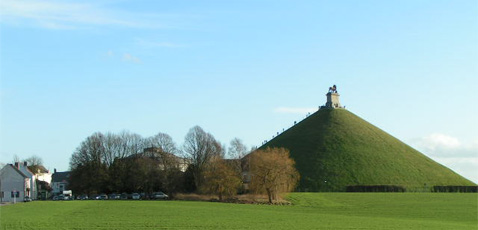Presentation
At your service Tourism
Ecotourism Event SPECIAL Vehicles
Contact us Other Partners Smartphones Important info
Conditions Legislation & Regulations Legal Search
|
Tourism - The Route Napoleon and Battle of Waterloo (1815)
The Route Napoleon and Battle of Waterloo (1815) The Route Napoleon in Belgium starts at Beaumont, on the french-belgian border, where the Emperor stayed close to the Salamander Tower for the night of 14-15 June 1815. Up towards Charleroi on the 15th of June, the French soldiers cross through the region of the Entre-Sambre-et-Meuse, where traditional costumed marches are still held today in Thuin, Ham-sur-Heure and Gerpinnes. In Charleroi, Napoleon established his headquarters in the Puissant castle located in the lower town. The building was destroyed, but a plate commemorates the passage of the Emperor. Fleurus-Ligny is the place of Napoleon's last victory (against Blücher's Prussians in the Battle of Ligny) on the 16th of June, two days before Waterloo. The Naveau mill served as observatory to the French. The defeated Prussian army will not retreat to the east (as could have been expected), but rather move to Wavre, from where it will march to Plancenoit in support to Wellington. Wellington and Blücher will meet in the late evening of the 18th at the Belle-Alliance farm. The Quatre-Bras crossroad, held by the Prince of Orange and Wellington against Marshall Ney, was abandoned, and Wellington withdrew northwards on the 17th, to the defensive position of the Mont-Saint-Jean ridge, south of Waterloo and the Sonian forest. At Vieux-Genappe, Napoleon set up his headquarters at the Caillou farmhouse. Then, direction Braine-l'Alleud where the Hougoumont and La Haie Sainte farms played an important role in the battle. The Waterloo Battlefield, near Brussels in Belgium, was the site of the final battle of the Napoleonic Wars. The Battle of Waterloo saw the French forces led by Napoleon Bonaparte clash with the coalition of British, Belgian, Dutch and German soldiers led by the Duke of Wellington and Prussian forces under the command of Gebhard Leberecht von Blücher. Napoleon's strategy was to capture Brussels and separate the armies of Wellington and Blücher, with the aim of prompting each to retreat. However, despite defeating the Prussians on 16th June at the Battle of Ligny, he was unable to force them to retreat entirely, meaning they were still free to support Wellington's force. Needing a decisive victory to prevent an invasion of France, Napoleon decided to attack. The two sides met at Waterloo Battlefield on the morning of 18 June 1815. The forces present were: - The French Grande Armée: 125,000 men. It consisted of conscripts, excellent units, seasoned troops, survivors of the Empire or of the Spanish War… - The Allies: 210,000 men, consisting of: • A British army made up, for half of them, of British soldiers, for the rest of German mercenaries, well-trained and with an iron discipline. Reputation for being resolute in defence. • A Dutch army forming an integral part of Wellington’s forces and commanded by the Prince of Orange-Nassau. • A Prussian army, extremely strongly motivated, driven by a growing sense of German nationalism and by a spirit of vengeance against France. Not very experienced and not too hardy, but numerous. The artillery of the time essentially consisted of cannons. The principal ammunition was a cannonball with a weight that could be 6, 8, 9 or 12 pounds depending on the type of cannon, with a maximum range of more than a kilometre for the 12 pound guns. These cannonballs were of cast iron and did not explode. The battle lasted eight hours and ended in the dramatic defeat of Napoleon. The Battle of Waterloo was extremely close-run and much of it was a result of both timing and the communication. In fact, Wellington himself decried that it was "the nearest run thing you ever saw in your life". The Napoleon Route ends at the site of the Battle of Waterloo and its famous Lion Mound. For France the result of the Battle of Waterloo would mean the second restoration of King Louis XVIII and the end of over two decades of war. For Napoleon, it meant the end of his rule and his career. Napoleon was exiled to Saint-Helena, where he died in 1821. As a result of Napoleon's defeat at Waterloo in 1815, the today's Benelux (Belgium, the Netherlands and the Grand-Duchy of Luxembourg) will be unified and form the Kingdom of the Netherlands led by William of Orange. Belgium will become independent in 1830, and the Grand-Duchy of Luxembourg in 1867. In our day tour you will experience and explore - the battle at the Quatre-Bras (June 16) - Genappe (June 17 - evening June 18) - The Waterloo Battlefield site: the Caillou Farm and Hougoumont Farm - free time for lunch, souvenirs, ... at the Lion Mound - stop at the crossroad Route du Lion / Chaussée de Charleroi, for a gobal presentation of the battlefield and what happened - The Papelote Farm: Wellinton's left wing and the Prussian's right wing - The Belle-Alliance Farm - Plancenoit - The Wounded Eagle (Aigle Blessé) Monument: the end of the battle. Private (= only you / your group on board) guided tour for up to 6 people with our Hyundai van, or up to 18 people with our Iveco coach. Battlefield guide on board. The tour includes some walking. The tour can be customized. One day tour, or more (the Battle of Ligny and/or Wavre, for example). As an introduction to the Battle of Waterloo, we suggest you to watch part 1 of a series, recounting the premises of this battle:
Watch the other parts here: part 2, part 3, part 4 and part 5. Contact us for more details : Scenic Tours sprl Creation date : 17/02/2013 @ 09:35 |


Powered by GuppY v2.4 - GNU Public License - © 2004-2012 Thierry Houba

 © 2004-2007
© 2004-2007 

Document generated in 0.04 second
 Acheter un appartement en Espagne
Acheter un appartement en Espagne


 Top
Top 








